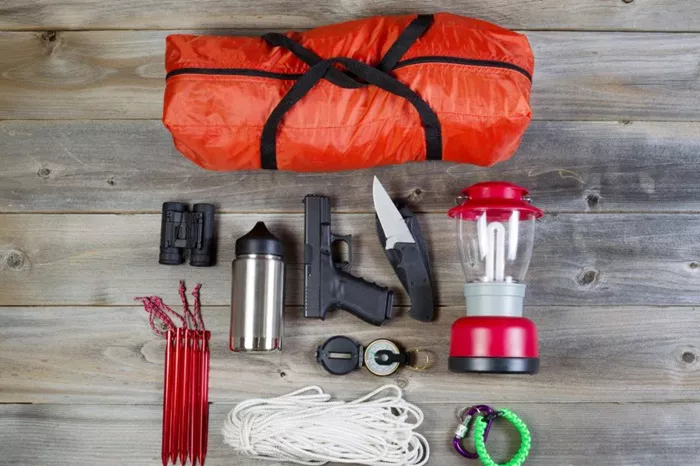Camping is a fantastic way to connect with nature, unwind, and create lasting memories. Whether you’re a seasoned camper or a beginner, knowing what to bring is essential for a successful trip. This guide covers everything you need to pack for your tent camping adventure.
1. Shelter and Sleeping Gear
Your tent is your home away from home. Here’s what to include:
Tent
Choose the Right Size: Consider how many people will sleep in the tent. Make sure it offers enough space for everyone and their gear.
Weather-Resistant: Ensure your tent is waterproof and has good ventilation. This will keep you dry and comfortable.
Ground Tarps
Protection: Place a tarp under your tent to protect it from moisture and sharp objects.
Extra Space: A tarp outside your tent provides additional dry space for gear.
Sleeping Bag
Temperature Rating: Choose a sleeping bag appropriate for the season. Look for a bag that keeps you warm but isn’t too heavy.
Packability: Opt for a sleeping bag that compresses easily for transport.
Sleeping Pad or Air Mattress
Comfort: A sleeping pad adds cushioning and insulation from the ground.
Inflatable or Foam: Choose between an inflatable air mattress or a foam pad based on your comfort preference and ease of setup.
Pillow
Packable Options: Bring a travel pillow or stuff a soft jacket into a stuff sack to create a makeshift pillow.
2. Cooking and Food Supplies
Food is an essential part of camping. Here’s how to prepare meals in the great outdoors.
Camping Stove or Grill
Portable Cooking: A compact camping stove or portable grill is necessary for cooking.
Fuel: Bring the appropriate fuel for your stove or grill.
Cookware
Pots and Pans: Lightweight pots and pans are ideal for cooking over a campfire or stove.
Utensils: Don’t forget spatulas, ladles, and other utensils you may need.
Eating Utensils
Plates and Bowls: Use lightweight, durable plates and bowls.
Cutlery: Bring forks, knives, and spoons. Consider reusable options to reduce waste.
Food Storage
Cooler: If you have perishable items, a cooler keeps them fresh.
Bear-Proof Containers: In bear country, use bear-proof containers to store food safely.
Food Supplies
Non-Perishable Foods: Bring items like pasta, rice, canned goods, nuts, and dried fruits.
Snacks: Pack granola bars, trail mix, and jerky for easy snacking.
Water
Water Bottles or Hydration Packs: Carry enough water for drinking and cooking.
Water Filter or Purification Tablets: If you’re near a water source, these can make water safe to drink.
3. Clothing and Personal Items
Dress appropriately for the weather and activities.
Clothing Layers
Base Layer: Moisture-wicking shirts and pants keep you dry.
Insulation Layer: Bring fleece or down jackets for warmth at night.
Outer Layer: A waterproof and windproof jacket is essential.
Footwear
Hiking Boots or Shoes: Wear sturdy, comfortable shoes for walking and hiking.
Sandals: A pair of lightweight sandals is great for relaxing at the campsite.
Accessories
Hat and Sunglasses: Protect yourself from the sun.
Gloves: Bring gloves if you expect cold weather.
Personal Items
Toiletries: Pack biodegradable soap, toothbrush, toothpaste, and other personal hygiene items.
Towel: A quick-dry towel is useful for washing up.
4. Safety and First Aid
Being prepared for emergencies is crucial.
First Aid Kit
Essential Supplies: Include adhesive bandages, antiseptic wipes, gauze, tape, pain relievers, and any personal medications.
Navigation Tools
Map and Compass: Even if you have a GPS, it’s smart to carry a physical map and a compass.
GPS Device: Consider a portable GPS or smartphone app for navigation.
Multi-tool or Knife
Versatile Tool: A multi-tool is helpful for many tasks, from food preparation to gear repair.
Fire Starter
Matches or Lighter: Bring waterproof matches or a reliable lighter for starting fires.
Fire Starter Kit: Consider fire starters like kindling or fire starter cubes.
5. Lighting and Tools
When the sun goes down, you’ll need some light.
Headlamp or Flashlight
Hands-Free Option: A headlamp is great for moving around at night.
Spare Batteries: Always bring extra batteries for your light sources.
Lantern
Camp Lighting: A portable lantern can light up your campsite for cooking and socializing.
6. Recreation and Entertainment
Make the most of your time outdoors.
Outdoor Games
Fun Activities: Bring a frisbee, cards, or travel-sized board games for entertainment.
Books or Journals
Relaxation: A good book or a journal for writing can be enjoyable during downtime.
Binoculars
Wildlife Viewing: Bring binoculars for bird watching or observing wildlife.
7. Cleanup and Waste Management
Keeping your campsite clean is vital for the environment.
Trash Bags
Pack It In, Pack It Out: Bring trash bags to collect your waste and keep the area clean.
Cleaning Supplies
Biodegradable Soap: Use eco-friendly soap for washing dishes.
Sponge and Cloth: Bring a sponge and cloth for cleaning up.
8. Optional Gear
Depending on your needs and preferences, consider these additional items:
Camping Chair
Comfort: A lightweight camping chair can provide comfort while sitting around the campfire.
Portable Shower
Hygiene: If you’ll be camping for several days, a portable shower may be a welcome addition.
Power Bank or Solar Charger
Charging Devices: A power bank or solar charger keeps your devices charged while off the grid.
Insect Repellent and Sunscreen
Protection: Insect repellent keeps bugs away, while sunscreen protects your skin from UV rays.
9. Final Tips for Packing
Make a Checklist
Preparation: Create a detailed checklist of everything you need to pack to avoid forgetting anything.
Pack Efficiently
Organize Gear: Use packing cubes or bags to keep similar items together for easy access.
Weight Distribution: Distribute weight evenly in your backpack for comfortable carrying.
Check the Weather
Be Prepared: Look at the weather forecast before your trip. Adjust your packing list accordingly.
Conclusion
Camping in a tent is a rewarding experience that allows you to connect with nature. By preparing adequately and packing the right gear, you can ensure a comfortable and enjoyable trip. Always remember to respect the environment and follow the Leave No Trace principles. Happy camping!
Related topics:

